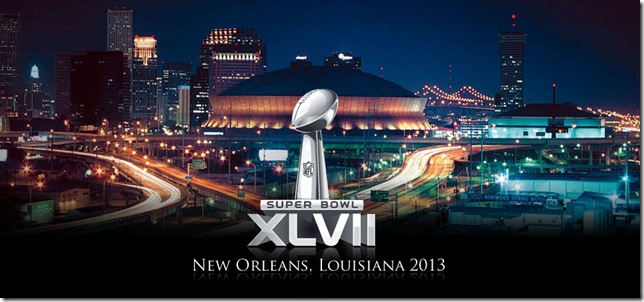By Myles Ludwig
I’ll watch the game even though the Superdome could very well be the graveyard of the Super Bowl. The last touchdown, the last time, America’s Big Game, as CNN calls it, crushes every demographic ― gender, class, age, household income ― beneath its cleats.
But I’m well aware that the Super Bowl Backlash has begun.
Maybe that’s because America’s Big Game is draped in the quasi-sacred trappings of national holiday like Christmas or Thanksgiving, rocketing out of the realm of sport and into the cosmos of spectacle where commerce and celebrity intertwine. The ads (60 minutes worth of stupid pet tricks at $8 million a minute in a country with 7.9 percent unemployment); the half-time show (BeyonceGate); even the closely guarded and carefully leaked identity of the national anthem singer. All these seem to have finally superseded the action on the field (who is playing?) and has, therefore, fertilized the field of the sport’s demise.
I do think it’s sad to see how often success eats its young, not only in America, but in China as well where they prefer to eat the feet rather than the wings.
It’s entirely possible that more than 100 million Americans and another 50 million or so aliens, illegal or not, (more than the population of, say, Guinea-Bissau) will no longer gather in front of their 90-ince HD-hearths every February. Think of it: no more nachos, no more chicken wings (about 1.25 billion, by the poultry industry’s reclassification of what constitute the wings that turbocharge each chicken crossing the road), no more pizza (more than 23 million feet); no more Himalaya of Pringles; no more convoy of dump trucks unloading enough pretzels and tortilla chips to fill the Grand Canyon; no more bayous of salsa, guacamole, and French onion soup dip; no more Katrina’s-worth of Costco beer and burp.
No more Monday morning freak-outs to burn off the estimated 1,200 calories each of us is predicted to consume during the game, a stuffing second only to Thanksgiving, our nationally sanctioned day of gorging. We’re talking seven hours of Pilates in a country where 15-25 percent of children and adolescents are considered obese. No more ritualistic video rage. Yo, catch it! No more live blogs, tweets and texts. No more Ray Lewis.
If this is the end, it’s fitting it comes in the place that was a notoriously inadequate shelter for victims of a catastrophe the rest of America watched in comfort. Fitting that the sideline medical team now includes neurologists as well as the usual squads of official lidocaine and deer antler dust sprayers. Fitting that our various venerated TV medicine men, our populist Prez, whose hobby has been revealed to be the elite sport of skeet shooting, and even the slithery Matt Lauer, whose chief skill is currying favor, are reticent to let their kids to play a game in which slo-mo suicide increasingly looks like the price of winning.
But I’ll watch the game because I’m no anti-gridiron activist.
Football has played an important role in my life, though I never played the game, never had a favorite team. But, I remember when, as a teenager with polio, I went to our high school’s homecoming game to win a 25 cent bet with my uncle Herb (a reverse-psychology incentive), bundled up in a wheelchair on a snowy and blustery November day in New Bedford. It was a personal victory. I remember broadcasting color and statistics for my high school games on the radio ― no video streaming in those days. It was so cold in that rickety press box above the bleachers I’d rush home after the game to uncurl my fingers by running them under the hot water.
Football was a bridge between my father and me. He was a fan. I recall his joy when we went to the annual Brown University game at Thanksgiving with his friend Joe Silverstein. My father never finished college, but this allowed him to live out his alma mater fantasies. He had been in the army during World War II, island-hopping with MacArthur, and I recall his pride when we went to a West Point game overlooking the Hudson River Valley. We went to Yale games in New Haven, to Tar Heel games at Carolina.
There is a kind of poignancy to the game in my memory, an innocence extending even to the tailgating, binge-drinking and frat house carousing. Our cheerleaders were the epitome of cuteness, our quarterbacks were truly heroic, lettermen ― rather than businessmen in shoulder pads playing through pain.
And New Orleans. I’ve only been there once, but I felt immediately at home. I remember well the funky Rock ‘N Bowl and the heavy-bottomed blonde who coaxed me onto the dance floor, showing me how to twirl her to the driving, joyfully syncopated rhythm of the non-stop zydeco band. I remember celebrating my birthday there, alone in a restaurant that bore my mother’s name, and the lovely elderly mother and her middle-aged daughter at the next table who invited me to share the occasion with them, though we’d never met before.
Every TV show that celebrates the best of the Crescent City, from Treme to today, brings on a yearning to return. I’ve harbored a life-long ambition to be there at Mardis Gras and a not-so-secret desire to end my days with a jazz funeral, even if it’s a klezmer band followed by a parasol-waving, yarmulke-topped second line.
“Death is always with us, but life is upon us,” said Wynton Marsalis, our socially-acceptable version of Louis Armstrong.
Maybe I’m wrong about the end of the game. Maybe it will, like New Orleans itself, rise from its own ashes and find a way to fly. I hope so.
Myles Ludwig is a media savant living in Lake Worth.
